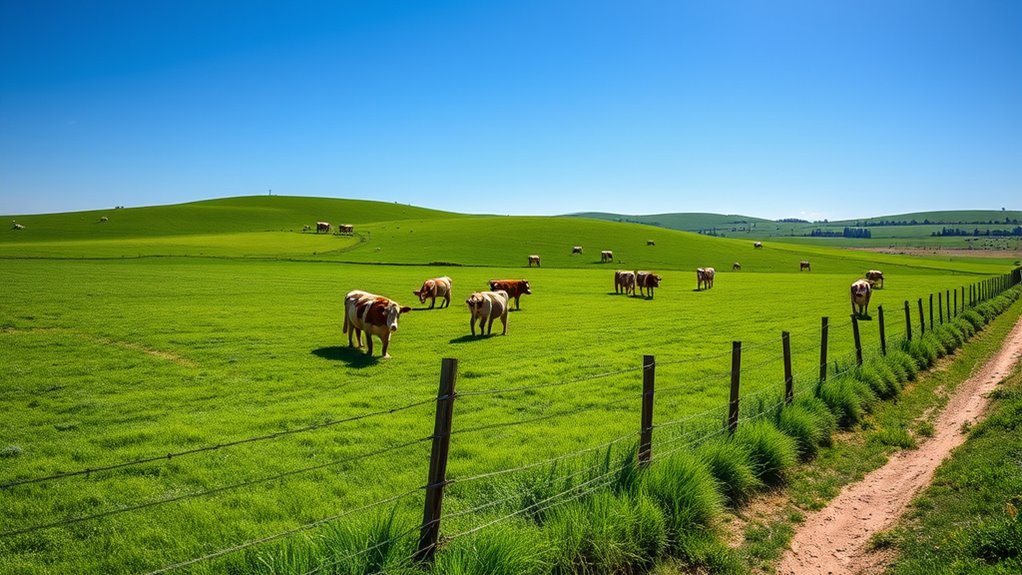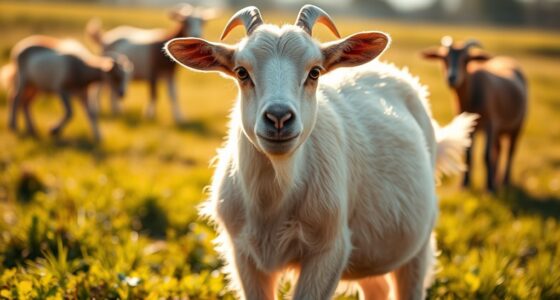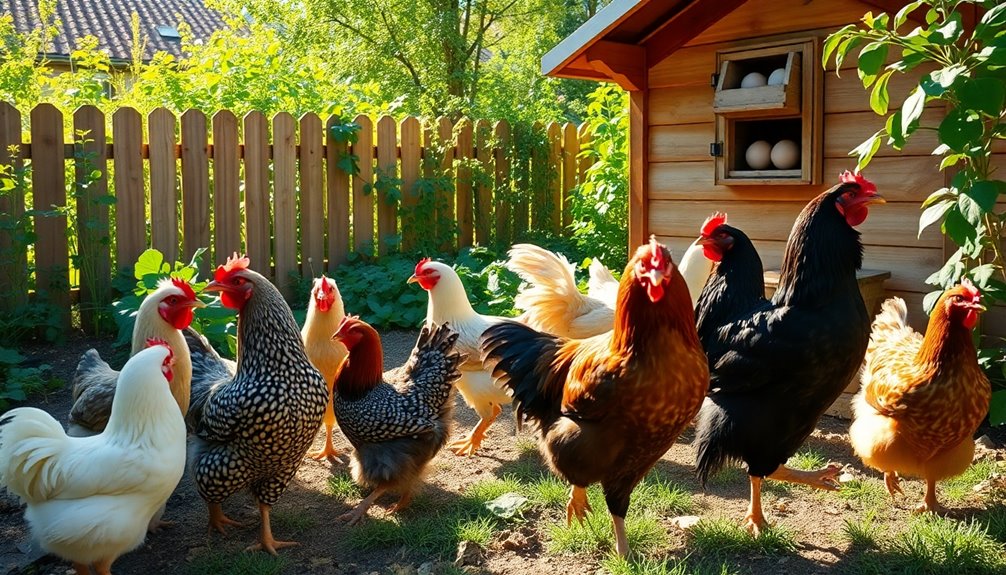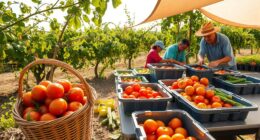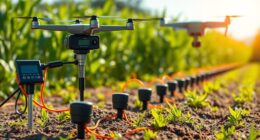Pasture-based dairy farming benefits you by promoting healthier, happier cows and producing higher-quality milk. It supports environmental health through biodiversity and reduces chemical use. However, it also requires careful land management, especially during seasonal changes when pasture growth slows, and weather impacts vary. Managing these challenges guarantees sustainable success. To understand how to balance these benefits and obstacles effectively, explore further options tailored for your farm’s needs.
Key Takeaways
- Pasture-based dairy promotes healthier animals and higher-quality milk by allowing natural grazing behaviors.
- Implementing sustainable grazing practices helps prevent land degradation and supports biodiversity.
- Seasonal feeding strategies optimize resource use and ensure cow nutrition during varying pasture growth periods.
- Regular pasture monitoring enhances land management, animal health, and productivity.
- Challenges include weather variability and the need for ongoing education to maintain ecological and economic balance.
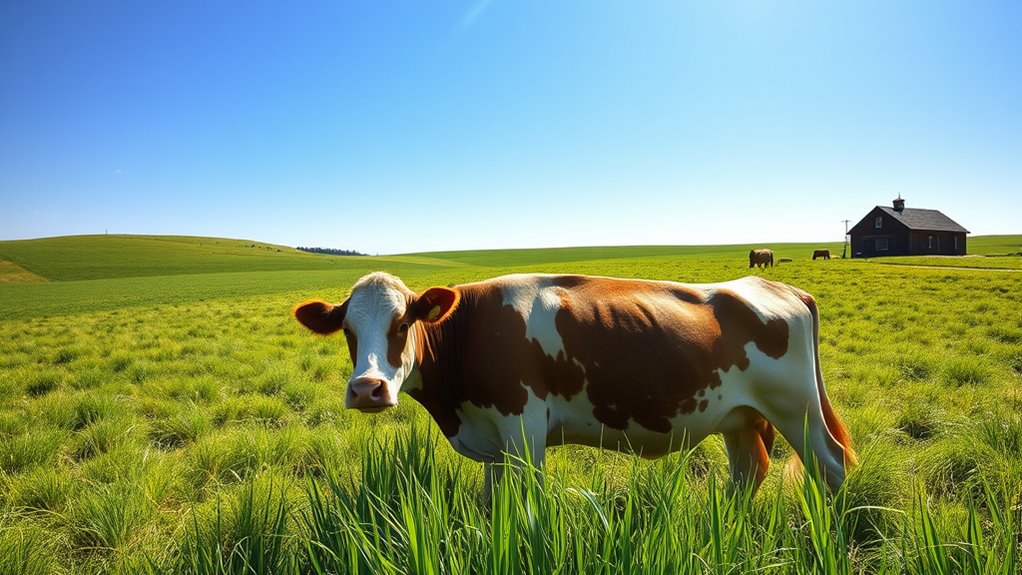
Pasture-based dairy farming emphasizes the significance of raising cows on open, grazing land rather than in confined spaces. This approach allows your cows to roam freely, grazing on fresh pasture, which promotes healthier animals and produces higher-quality milk. Engaging in sustainable grazing practices is vital here; it involves rotating your pastures to prevent overgrazing, maintaining soil health, and making certain that your land can support your herd over the long term. By managing grazing patterns carefully, you help protect the environment and foster a resilient ecosystem that benefits both your cows and the land they depend on. Seasonal feeding plays a pivotal role in this system. During different times of the year, you’ll adjust your grazing and supplemental feeding strategies to match the availability of pasture. In spring and summer, cows can mostly rely on fresh grass, which is naturally more nutritious and abundant. As seasons change and pasture growth slows in fall and winter, you might need to supplement their diet with hay or silage to meet nutritional needs without stressing the land. This seasonal feeding approach not only sustains your cows through leaner months but also guarantees you’re utilizing resources efficiently, reducing waste and reliance on imported feeds. Additionally, monitoring pasture conditions regularly helps you make informed decisions and optimize grazing schedules for better health and productivity. You’ll find that managing pasture-based dairy farming demands attention to detail and planning. It requires you to monitor pasture conditions regularly and adapt your grazing schedules to optimize forage growth and animal health. Properly implementing sustainable grazing techniques helps prevent land degradation, supports biodiversity, and reduces the need for chemical inputs. Moreover, by aligning your feeding practices with seasonal changes, you can improve milk quality and animal well-being, since cows thrive when their diet matches their natural grazing instincts and seasonal availability. This method also encourages a more humane and natural environment for your herd, which can translate into happier, healthier cows that produce better milk.
However, the challenges shouldn’t be overlooked. Weather variability can affect pasture growth, and managing seasonal feeding requires flexibility and careful planning. You might face periods when pasture growth slows considerably, demanding extra effort to supplement feed without disrupting the ecological balance. Additionally, maintaining sustainable grazing practices involves ongoing education and vigilance, ensuring that your land remains productive and resilient for years to come. Despite these hurdles, the benefits of pasture-based dairy—like improved animal health, superior milk quality, and environmental sustainability—make it a compelling choice. Your commitment to managing seasonal feeding and sustainable grazing practices ultimately supports a more natural, eco-friendly, and profitable dairy operation.
Frequently Asked Questions
How Does Pasture-Based Dairy Impact Cow Health and Welfare?
You notice that pasture-based dairy positively impacts cow health and welfare by encouraging natural grazing behavior. Grazing allows cows to exhibit their instincts, reducing stress and promoting overall well-being. Additionally, it aids in disease prevention, as cows have better airflow and cleaner environments compared to confined systems. This approach supports healthier, happier cows, leading to improved milk quality and farm sustainability.
What Are the Environmental Effects of Pasture-Based Dairy Systems?
You’ll find that pasture-based dairy systems generally reduce soil erosion because grass cover stabilizes the soil. However, they can impact biodiversity; if not managed properly, they may lead to habitat loss or a decrease in native species. While these systems often have a lower carbon footprint, you should consider the balance between maintaining healthy ecosystems and preventing soil degradation to guarantee sustainable dairy farming.
How Does Pasture-Based Dairy Influence Milk Nutritional Quality?
Imagine lush green fields versus confined spaces—you influence milk’s nutritional quality. You’ll notice higher levels of beneficial milk fatty acids and increased vitamin content in pasture-based dairy. Grazing cows produce milk richer in omega-3s and conjugated linoleic acids, which promote health. This natural diet enhances the milk’s nutritional profile, offering you better health benefits and more wholesome products straight from pasture to table.
What Are the Economic Considerations for Farmers Switching to Pasture-Based Systems?
When switching to pasture-based systems, you should conduct a thorough cost analysis to understand potential savings and expenses. Although pasture-based farming may reduce feed costs and improve product quality, it might require investments in fencing and land management. Consider market access opportunities, as consumers often pay premium prices for pasture-raised dairy. Balancing these factors helps guarantee your shift is financially sustainable and aligns with market demand.
How Can Pasture-Based Dairy Be Scaled for Large Commercial Operations?
You can scale pasture-based dairy for large operations by implementing rotational grazing to optimize pasture use and maintain soil health. Efficient pasture management, including strategic fencing and land planning, allows you to manage larger herds sustainably. This approach reduces feed costs and enhances milk quality. Invest in infrastructure and technology to monitor pasture conditions and herd movement, making sure your system stays productive and environmentally friendly as you grow.
Conclusion
Imagine your dairy farm as a garden thriving with lush pasture, where cows graze freely and produce high-quality milk. While the benefits are clear—better animal health and sustainability—challenges like weather unpredictability can threaten this harmony. Just like tending a garden requires resilience and care, managing a pasture-based dairy demands attention and adaptability. Embrace these efforts, knowing that the rewards—fresh milk and a healthier environment—are worth every drop of effort you put in.

